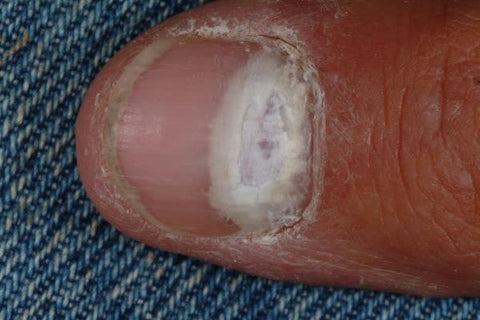FREE SHIPPING ON ORDERS $50+
*Some restrictions apply*

Dermatophytes, a type of fungus, typically cause fungal nail infections. The infection can begin as athlete’s foot, but this isn’t always the case. If the condition starts in the nails, often this fungus will spread to the skin and cause athlete’s foot. Dermatophytes can live on and in the nails, the skin, and the hair and spread quickly. It is essential to begin treating a nail infection as soon as possible to avoid growing, which means you’ll need to be able to recognize the symptoms effectively.
Fungal nail infections usually affect toenails but can affect fingernails as well. Gardeners are more susceptible to mold nail infections on their fingernails since this mold grows in soil. In the fingernails and toenails, these infections will start at the base of the nail and then spread to the nail itself. There are two common nail infections: distal subungual onychomycosis and white superficial onychomycosis. The difference between the two is in the parts of the nail it affects.

Distal subungual onychomycosis (left) is the more common of the two. This type of infection affects the nail bed, the skin underneath the nail, and the nail's surface. Once the fungus has taken hold, you will begin to see yellow spots or streaks, which will turn the whole nail yellow over time. Once the nail has turned yellow, the fungus will cause the nail to thicken. The nail will also become brittle and sometimes split or pull away from the nail bed. This excruciating process can even cause wearing shoes painful.

White superficial onychomycosis (right) only affects the nail's base and the nail's surface. The first symptom is white spots or streaks on the nail surface. As the infection progresses, the nail's character will turn completely white and become quite malleable and powdery. Without treatment, the condition will continue and cause the nail to crumble and even turn brown or gray. However, this type of infection will not cause the toenail to pull away from the nail bed since it will only grow on the nail's surface (hence, 'superficial').
To diagnose a nail infection, your doctor will first ask about your medical history to find out if you have previously had any nail infections. Once you get a fungal nail infection, it can quickly reoccur. Then your doctor will look at both your finger and toenails to look at the symptoms and check for ringworm and athlete’s foot since the same fungus causes these. Most doctors will make a diagnosis just based on these factors. Since dermatophytes cause most nail infections, he will, in all likelihood, prescribe treatment for that fungus. If this treatment does not work, you may need to return to your doctor and get a nail biopsy.
Naturasil nail infection products work for all types of nail infections, so it is not always necessary to figure out exactly which type of fungus is causing the infection. If you have a nail infection, start your treatment now to avoid the painful and embarrassing growth of the fungus.